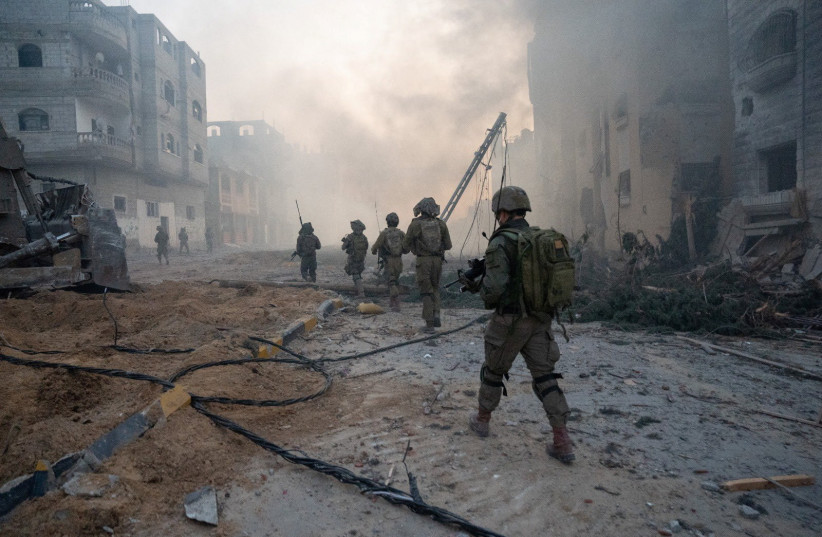Reports that a new deal may be in the works with Hamas to pause fighting in Gaza and enable hostages to be released raise concerns about Hamas demands.
The first deal was brokered in mid-November and saw fighting end for a week in late November. Hamas has suffered more losses since then, including the southern Gazan city of Khan Younis where the IDF has been operating since early December.
Yet, an ostensibly weakened Hamas, appears to be requesting even more from a new deal than it got from the first one.
Let’s start with the reports. The deal is reported to include a several-month pause in fighting in return for the release of most remaining hostages.
However, we’ve been misled in the past.
Previous Hamas lies
For instance, the first deal was supposed to include elderly hostages, women, and children. Only later it revealed that “women” meant older women and mothers and that it was always understood that younger women would be left in the hands of Hamas.
This tragic mistake followed increasing evidence of sexual abuse. Yet, no priority was placed on their release.

Also, Hamas lied about releasing the Bibas family, claiming they were being held by other groups or by private Gazan civilians. These claims are always floated when hostage talks begin so that Hamas can drag out the talks and pretend it doesn’t know where the hostages are.
This creates a contradiction. Why are the talks taking place with Qatar, which hosts Hamas, if Hamas doesn’t even hold all the hostages? If some of the hostages are held by Gazan civilians, then what’s the point of talking to Hamas via a country that hosts Hamas?
The Israeli public's reality
The Israeli public is nevertheless presented with this scenario: Hamas will do a deal, but Hamas doesn’t hold all the hostages, but Hamas will find them, but if Hamas doesn’t find them, that’s ok because then it will still get a pause in fighting to look for them or pretend to look for them, and then when it violates the deal that’s ok too because it was known all along Hamas couldn’t find them or Hamas was lying.
Hamas misled Israel the first time, followed by two more months of fighting, from December 1 to January 28 and now Hamas is once again in the driver’s seat trying to secure even more than it did back in November for fewer hostages.
If you realize something doesn’t make sense, you’re right. It doesn’t make sense that Hamas, weaker today than it was on November 24, is seeking to win a much longer respite to release fewer hostages.
The Israeli public deserves to know why young women have often been at the back of the line. The story is that Hamas claims the women are all soldiers and therefore deserve a “high price” for them.
Once again, this shows Hamas is the one driving these demands, even though it continues to lose territory and terrorists.
According to the IDF Hamas has lost 9,000 members of its terrorist army, roughly a third, and it has also lost thousands injured. The Jerusalem Post reported last week that up to 60% of Hamas terrorists are out of action.
On the other hand, reports also say that up to 80% of Hamas tunnels have not been destroyed. Many of those tunnels are in areas over which the IDF has tacit control, so finding them is only a matter of time.
But the point is that Hamas continues to have some command and control. It controls Rafah on the border and through that control, it controls humanitarian aid entering Gaza. Hamas may also be trying to infiltrate the 250,000 estimated Gazans who remain in the north.
The Hamas tentacles are waiting to grow back. If Hamas gets a months-long ceasefire, it can restore its tentacles, go back to the tunnels, recruit more terrorists from people in the humanitarian zone, and exploit the aid coming into Gaza to grow wealthy and powerful again.
These should be top concerns. Israel has been told that when the war is over Hamas won’t be in Gaza. That claim has been downgraded to: there won’t be a Hamas threat from Gaza.
With the first pause in November, reports said that military pressure had led to the successful release of hostages. Now, two months later, with additional military pressure, it appears that Hamas is trying to stack the deal to avoid releasing many hostages up front.
Considering that Hamas began this war with a genocidal attack on Israel, considering its known crimes, and considering that it violated the first deal, and has continued to influence Israel psychologically with hostage videos, granting Hamas a months-long ceasefire where it doesn’t have to fulfill its obligations immediately, is problematic.
Was this the Hamas plan all along? To attack on October 7, commit mass murder, rape, and destruction; then run back to Gaza with hostages, to hide in tunnels and wait out the war, which it expected would last maybe two months.
It did this in 2009 and 2014. Then it expected the international community to pressure Israel for a ceasefire, leaving its leadership intact and channels of funding from abroad open to rebuild its arsenal.
At the same time, it wanted to use the war to win concessions from Israel and broaden support for Hamas in the West Bank.
So far the Hamas leadership is mostly intact and its terror infrastructure too, even if damaged.
Hamas expects money and humanitarian aid to flow in so that it can continue to control Gaza’s civilians, whom it uses as human shields. It thinks time is on its side. Its push for a long ceasefire is evidence of this. It may have lost 15,000 terrorists, killed and wounded, but it can replace them slowly.
Therein lies the danger of a long ceasefire. Time is not on Israel’s side.
